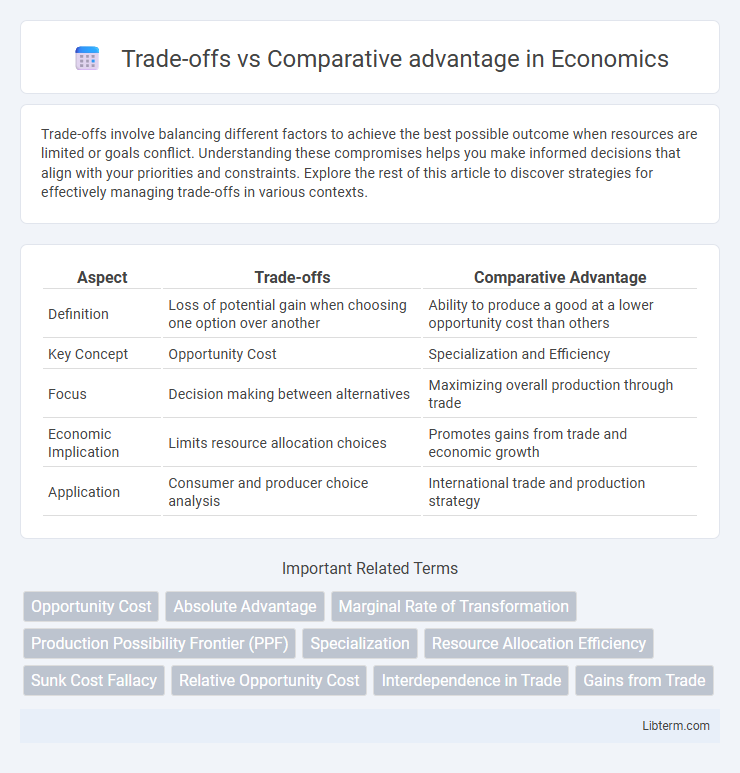Trade-offs involve balancing different factors to achieve the best possible outcome when resources are limited or goals conflict. Understanding these compromises helps you make informed decisions that align with your priorities and constraints. Explore the rest of this article to discover strategies for effectively managing trade-offs in various contexts.
Table of Comparison
| Aspect | Trade-offs | Comparative Advantage |
|---|---|---|
| Definition | Loss of potential gain when choosing one option over another | Ability to produce a good at a lower opportunity cost than others |
| Key Concept | Opportunity Cost | Specialization and Efficiency |
| Focus | Decision making between alternatives | Maximizing overall production through trade |
| Economic Implication | Limits resource allocation choices | Promotes gains from trade and economic growth |
| Application | Consumer and producer choice analysis | International trade and production strategy |
Introduction to Trade-Offs and Comparative Advantage
Trade-offs involve balancing different factors when choices require sacrificing one benefit to gain another, highlighting opportunity costs in decision-making. Comparative advantage refers to the ability of an individual, firm, or country to produce a good or service at a lower opportunity cost than others, enabling more efficient resource allocation. Understanding trade-offs and comparative advantage helps explain how specialization and exchange improve overall economic efficiency.
Defining Trade-Offs in Economic Decision-Making
Trade-offs in economic decision-making refer to the necessity of sacrificing one option to gain another due to scarce resources. This concept underlines that choosing more of one good or service results in having less of another, emphasizing opportunity cost. Understanding trade-offs helps individuals and firms optimize resource allocation by weighing benefits against costs within limited constraints.
What Is Comparative Advantage?
Comparative advantage refers to the ability of an individual, firm, or country to produce a good or service at a lower opportunity cost than others, enabling more efficient resource allocation and specialization. Unlike trade-offs, which involve sacrificing one option for another, comparative advantage highlights the benefits of focusing on activities where one has the lowest relative cost, leading to gains from trade. This concept underpins international trade theory by explaining how countries can mutually benefit through specialization and exchange.
Key Differences Between Trade-Offs and Comparative Advantage
Trade-offs involve sacrificing one option to gain another due to limited resources, highlighting opportunity costs in decision-making. Comparative advantage refers to the ability of an entity to produce goods or services at a lower opportunity cost than others, enabling more efficient specialization. The key difference lies in trade-offs addressing individual or production choices versus comparative advantage emphasizing relative efficiency and mutually beneficial trade.
Opportunity Cost: The Foundation of Both Concepts
Opportunity cost underpins both trade-offs and comparative advantage by quantifying the value of the next best alternative foregone when a choice is made. Trade-offs involve sacrificing one resource or benefit to gain another, reflecting the opportunity cost of decision-making at an individual or organizational level. Comparative advantage arises when entities specialize in producing goods or services at a lower opportunity cost than others, enabling more efficient resource allocation and mutually beneficial trade.
Real-World Examples of Trade-Offs
Trade-offs occur when countries must allocate limited resources between competing needs, exemplified by Brazil choosing to invest in agriculture over manufacturing, impacting its industrial growth. Comparative advantage highlights that Brazil produces coffee more efficiently than cars, encouraging specialization and trade despite these trade-offs. Real-world trade-offs also appear when the U.S. prioritizes technology innovation over traditional industries, balancing economic growth with potential job displacement.
Illustrating Comparative Advantage with Simple Models
Comparative advantage is illustrated through simple economic models that highlight how individuals or countries can gain by specializing in the production of goods for which they have the lowest opportunity cost, rather than focusing on trade-offs involving absolute efficiency. For instance, the classic model between two countries producing only two goods demonstrates that even if one country is less efficient at producing both goods, it benefits from specializing in the good with the least relative inefficiency. This specialization, driven by comparative advantage, underpins the mutual gains from trade beyond mere consideration of production trade-offs.
How Trade-Offs Influence Specialization and Trade
Trade-offs determine the opportunity cost of allocating resources to produce one good over another, directly impacting the extent of specialization in an economy. When countries or individuals face trade-offs, they concentrate production on goods with the lowest opportunity cost, leading to comparative advantage. This specialization based on comparative advantage enhances overall efficiency, enabling mutually beneficial trade that optimizes resource allocation and maximizes total output.
The Role of Comparative Advantage in Global Economy
Comparative advantage drives global trade by enabling countries to specialize in producing goods and services where they have lower opportunity costs, maximizing overall economic efficiency. Trade-offs occur as nations allocate resources to areas with the greatest comparative advantage, foregoing alternative production possibilities to enhance global output. This specialization fosters increased productivity, economic growth, and the expansion of international markets.
Conclusion: Choosing Between Trade-Offs and Comparative Advantage
Choosing between trade-offs and comparative advantage requires evaluating opportunity costs and resource efficiency to maximize economic gains. Trade-offs highlight the sacrifices involved in allocating resources, while comparative advantage identifies the most efficient production focus for each party. Prioritizing comparative advantage typically yields greater collective benefits by leveraging specialization and minimizing opportunity costs.
Trade-offs Infographic

 libterm.com
libterm.com